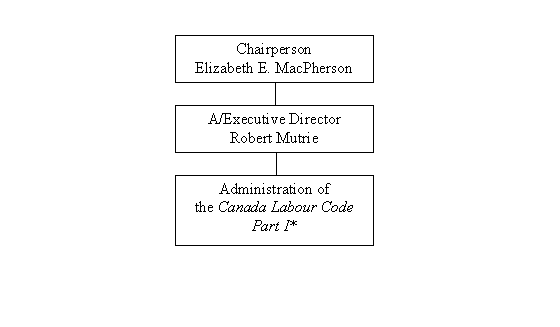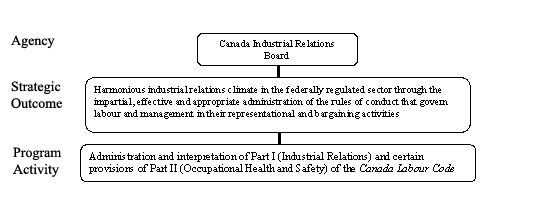Common menu bar links
Breadcrumb Trail
ARCHIVED - Canada Industrial Relations Board
 This page has been archived.
This page has been archived.
Archived Content
Information identified as archived on the Web is for reference, research or recordkeeping purposes. It has not been altered or updated after the date of archiving. Web pages that are archived on the Web are not subject to the Government of Canada Web Standards. As per the Communications Policy of the Government of Canada, you can request alternate formats on the "Contact Us" page.
SECTION I–OVERVIEW
1.1 Message from the Chairperson
 I am pleased to present to Parliament and to Canadians the 2008–09 Report on Plans and Priorities for the Canada Industrial Relations Board (CIRB or Board). As the newly appointed
Chairperson of the Board, I feel very privileged to have been given the opportunity to lead an organization that has such an important role in the workings of the Canadian labour relations system, and on the relationship between employees and employers in the federally regulated sector.
I am pleased to present to Parliament and to Canadians the 2008–09 Report on Plans and Priorities for the Canada Industrial Relations Board (CIRB or Board). As the newly appointed
Chairperson of the Board, I feel very privileged to have been given the opportunity to lead an organization that has such an important role in the workings of the Canadian labour relations system, and on the relationship between employees and employers in the federally regulated sector.
The number of applications/complaints received by the Board is expected to increase slightly in 2007–08, but should remain significantly lower than the levels that prevailed in the 2000–01 to 2005–06 period. Given the uncertain economic climate, particularly the possibility of a recession in the United States and the effects of the recent strength of the Canadian dollar against its U.S. counterpart, it is difficult to predict what the volume of cases received may be in 2008–09. More cases have been disposed of than were received in 2007–08, and as a result, the number of backlog cases is expected to drop to 611 as of March 31, 2008, the lowest level since 1997–98. Further concerted efforts will be made during 2008–09 to significantly reduce this backlog.
It is my intention to continue the good work initiated by my predecessor, and to actively encourage the settlement of labour-management disputes. My personal priority is to find ways to accelerate the reduction of the number of backlog cases that remain on the Board’s books, and to ensure that the Board achieves its mandate of contributing to and promoting a harmonious industrial relations climate in the federally regulated sector as effectively and efficiently as possible.
I look forward to leading the CIRB in the achievement of its goals in 2008–09. I am confident that the Board members and staff remain strongly committed to renewing their efforts in the year ahead to make the CIRB more responsive to its constituency, and to find new opportunities that will increase its productivity and gain greater efficiencies.
Chairperson
1.2 Management Representation Statement
I submit for tabling in Parliament, the 2008–09 Report on Plans and Priorities for the Canada Industrial Relations Board.
This document has been prepared based on the reporting principles contained in the Guide to the Preparation of Part III of the 2008–09 Estimates: Reports on Plans and Priorities and Departmental Performance Reports:
- it adheres to the specific reporting requirements outlined in the Treasury Board of Canada Secretariat guidance;
- it is based on the department’s strategic outcome(s) and program activity that were approved by the Treasury Board;
- it presents consistent, comprehensive, balanced and reliable information;
- it provides a basis of accountability for the results achieved with the resources and authorities entrusted to it; and
- it reports finances based on approved planned spending numbers from the Treasury Board of Canada Secretariat.
Chairperson
1.3 Raison d’être
The mandate of the Canada Industrial Relations Board is to contribute to and promote a harmonious industrial relations climate in the federally regulated sector through the impartial, effective and appropriate administration of the rules of conduct that govern labour and management in their representational and bargaining activities. In achieving this strategic outcome, the Board provides effective industrial relations solutions for the Canadian labour relations community in a fair and timely manner.
1.4 Organizational Information
Accountability

*The Board also administers certain provisions of Part II, Occupational Health and Safety.
The Canada Industrial Relations Board is an agency operating under the Minister of Labour’s portfolio.
Information on the Board members can be found at: http://www.cirb-ccri.gc.ca/about/members/index_e.asp
1.5 Context and Background
The Canada Industrial Relations Board (CIRB) is an independent, representational, quasi-judicial tribunal responsible for the interpretation and application of the Canada Labour Code (the Code), Part I, Industrial Relations, and certain provisions of Part II, Occupational Health and Safety. It was established in January 1999, to replace the previous Canada Labour Relations Board (CLRB), through amendments to Part I of the Code.
The adjudicative team of the Board is currently composed of the Chairperson, four full-time and four part-time Vice-Chairpersons, and six full-time and three part-time members—all of whom are Governor in Council (GIC) appointments. The Code requires that the Chairperson and Vice Chairpersons must have experience and expertise in industrial relations, and that members are to be appointed by the Minister of Labour, after consultation with the organizations representative of employees or employers.
The CIRB has jurisdiction in all provinces and territories with respect to federal works, undertakings or businesses in the following sectors:
- Broadcasting
- Chartered banks
- Postal services
- Airports and air transportation
- Shipping and navigation
- Inter-provincial or international transportation by road, railway, ferry or pipeline
- Telecommunications
- Grain handling and uranium mining and processing
- Most public and private sector activities in the Yukon, Nunavut and the Northwest Territories
- Band Councils and some First Nations undertakings
- Certain Crown corporations (including, among others, Atomic Energy of Canada Limited and the national museums).
This jurisdiction covers some 800,000 employees and their employers, and includes enterprises that have an enormous economic, social, and cultural impact on Canadians from coast to coast. The variety of activities conducted by the federally regulated sector, as well as its geographical spread and national significance, contribute to the uniqueness of the federal jurisdiction and the role of the CIRB, and pose particular challenges for the Board’s work.
The Board has established a series of strategic objectives in support of its mandate, which include to:
- seek solutions to labour relations problems by determining the cause and nature of conflict and by applying the appropriate dispute resolution mechanism, including fact finding, mediation and adjudication;
- conduct its activities in a fair, timely and consistent manner;
- consult its clients on its performance and on the development of policies and practices;
- promote an understanding of its role, processes and jurisprudence through client contact and a variety of information dissemination methods; and
- conduct its business and manage its resources in a manner that is fiscally sound, in accordance with the Financial Administration Act and the policies and directives of the central agencies of government.
1.6 Program Activity Architecture

1.7 Voted and Statutory Items Displayed in the Main Estimates
| Vote or Statutory Item ($ thousands) |
Truncated Voted or Statutory Wording | 2008–2009 Main Estimates |
2007–2008 Main Estimates |
| 10 | Program expenditures | 11,018 | 10,887 |
| (S) | Contributions to employee benefit plans | 1,490 | 1,550 |
| Total Agency | 12,508 | 12,437 |
1.8 Planned Spending and Full-time Equivalents (FTE)
|
|
||||
($ thousands) |
Forecast Spending 2007–2008 |
Planned Spending 2008–2009 |
Planned Spending 2009–2010 |
Planned Spending 2010–2011 |
|
|
||||
| Labour Relations Resolution Program | 12,437 | 12,508 | 12,508 | 12,508 |
|
|
||||
| Total Main Estimates* | 12,437 | 12,508 | 12,508 | 12,508 |
|
|
||||
| Adjustments: | ||||
| Supplementary Estimates | ||||
| Operating budget carry forward | 533 | |||
| Other | ||||
| Funding requirements for new collective agreements and other adjustments to terms and conditions of service or employment of the Public Service | 131 | |||
| Employee Benefit Plan (EBP) | -61 | |||
| Public Accounts Operating budget lapse | -300 | |||
|
|
||||
| Total Adjustments | 303 | 0 | 0 | 0 |
|
|
||||
| Total Planned Spending | 12,740 | 12,508 | 12,508 | 12,508 |
|
|
||||
| Total Planned Spending | 12,740 | 12,508 | 12,508 | 12,508 |
| Plus: Cost of services received without charge | 3,025 | 3,187 | 3,031 | 3,030 |
|
|
||||
| Total Departmental Spending | 15,765 | 15,695 | 15,539 | 15,538 |
|
|
| Full Time Equivalents | 103 | 110 | 110 | 110 |
|
|
||||
* The total main estimates for 2008–2009 and subsequent years is approximately $70,000 more than in 2007–2008, and represent adjustments in salary and benefits prescribed by collective agreements or by Treasury Board policy.
1.9 Summary Information
Financial Resources|
2008–2009
|
2009–2010
|
2010–2011
|
|
($ thousands)
|
($ thousands)
|
($ thousands)
|
|
12,508
|
12,508
|
12,508
|
Human Resources
|
2008–2009
|
2009–2010
|
2010–2011
|
|
FTEs
|
FTEs
|
FTEs
|
|
110
|
110
|
110
|
1.10 Departmental Plans and Priorities–Summary
Program Priorities|
Activity/Initiative
|
Type
|
| Deliver on the Board’s statutory mandate under the Canada Labour Code | Ongoing |
| Accelerate reduction in the number of backlog cases | Ongoing |
| Reduce average case disposition time | Ongoing |
| Review new duty of fair representation complaint process | Ongoing |
| Review the Board’s Performance Measurement Framework | New |
| Client consultations | Ongoing |
Details on the Board’s plans and priorities are provided in section II below.
